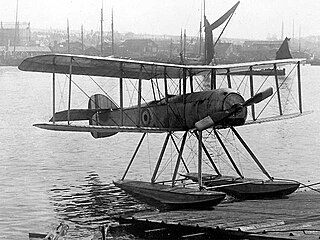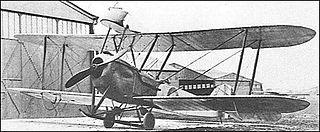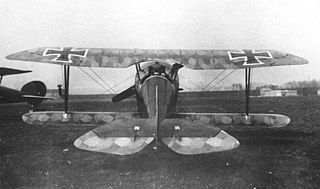
The Vickers F.B.5 was a British two-seat pusher military biplane of the First World War. Armed with a single .303 in (7.7 mm) Lewis gun operated by the observer in the front of the nacelle, it was the first aircraft purpose-built for air-to-air combat to see service, making it the world's first operational fighter aircraft.

The Vickers F.B.19 was a British single-seat fighting scout of the First World War, developed from the Barnwell Bullet prototype, and sometimes known as the Vickers Bullet. It served with the Royal Flying Corps and the Imperial Russian Air Service, which subsequently led to the Red Air Force adopting it during the Russian Civil War.

The Vickers Type 143 or Bolivian Scout was a British single-seat fighter biplane designed and built by Vickers in 1929–1930. Six were built for Bolivia in 1930, which used the survivors in the Chaco War against Paraguay.

The Wight Baby was a British single-seat seaplane fighter produced by John Samuel White & Company Limited. Only three prototype aircraft were built.

The Vickers F.B.26 Vampire was a British single-seat pusher biplane fighter built by Vickers during the First World War.

The Vickers F.B.14 was a British two-seat fighter/reconnaissance biplane designed and built by Vickers Limited. About 100 were built for the Royal Flying Corps but saw only limited use as it was designed for a larger engine which was not available when production commenced and it did not meet performance expectations.

The Morane-Saulnier AI was a French parasol-wing fighter aircraft produced by Morane-Saulnier during World War I.

The Vickers F.B.12 was a biplane pusher fighter aircraft developed during World War I by Vickers Limited. The failure of the engine for which it was designed, and the obsolescence of the pusher configuration, resulted in its remaining an experimental type only.
The Morane-Saulnier AF, also known as the Morane-Saulnier Type AF and the MoS 28 was a French First World War single-seat biplane fighter prototype from 1917.
The Port Victoria P.V.2 was a British prototype floatplane fighter of the First World War, designed and built at the Royal Naval Air Service's Port Victoria Marine Experimental Aircraft Depot on the Isle of Grain. Only a single aircraft was built, with the type not being chosen for production.
The Sage Type 2 was a prototype British two-seat fighter aircraft of the First World War. A single-engined biplane with an enclosed cabin for its crew, only a single example was built, as more advanced aircraft became available.

The Vickers F.B.11 was a prototype British three-seat escort fighter of the First World War. A large single-engined biplane, it carried one gunner in a nacelle mounted on the upper wing to give an allround field of fire. Only a single example was completed.

The Vickers E.F.B.7 was a prototype British fighter aircraft of the First World War. A twin-engined biplane, the E.F.B.7 was unsuccessful, only one being built.

The Vickers E.S.1 was an early British Fighter aircraft of the First World War. A single-seat biplane, only three E.S.1s were built, although at least one was used by a home defence squadron of the Royal Flying Corps.
The Sopwith Gunbus was a British fighter aircraft of the First World War. It was a single-engined pusher biplane based on a floatplane built by Sopwith before the war for Greece. Small numbers were built and used by the British Royal Naval Air Service, mainly as a trainer.

The Vickers F.B.16 was a British single-seat fighter aircraft of the First World War. It was originally designed to be powered by an experimental radial engine, development of which was abandoned. When re-engined with more powerful and reliable water-cooled V-8 engines, the F.B.16 demonstrated good performance, but only a few prototypes were built, the type not entering service.
The Vickers F.B.24 was a British two-seat fighter aircraft of the First World War. Only a few prototypes were built, as, although it had good performance, the Bristol F.2 Fighter was preferred.
The Vickers E.F.B.1 'Destroyer' was an early British military aircraft prototype. Although not itself a success, the design was considered worth developing, and a series of similar aircraft were produced in prototype form, eventually leading to the Vickers F.B.5 "Gunbus", which saw widespread service during World War I.

In October 1917 Nieuport began construction of a prototype monoplane fighter known as the Nieuport Madon, a strut braced monoplane.

The Kondor D 1, given the unofficial name Kondorlaus, was a German single seat, biplane fighter aircraft designed and built close to the end of WWI.














